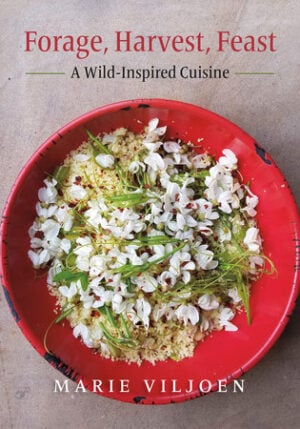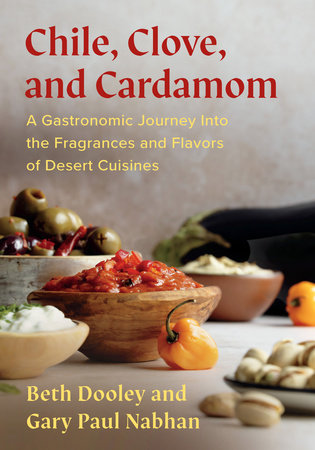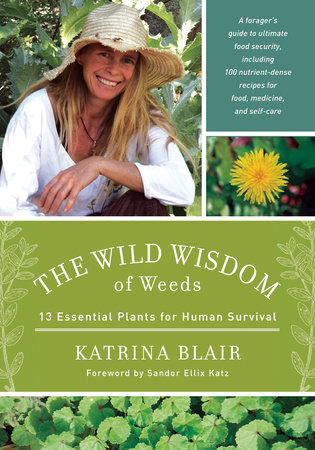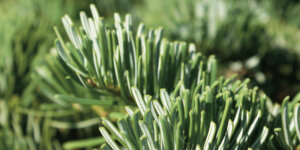An Amaranth Love Affair
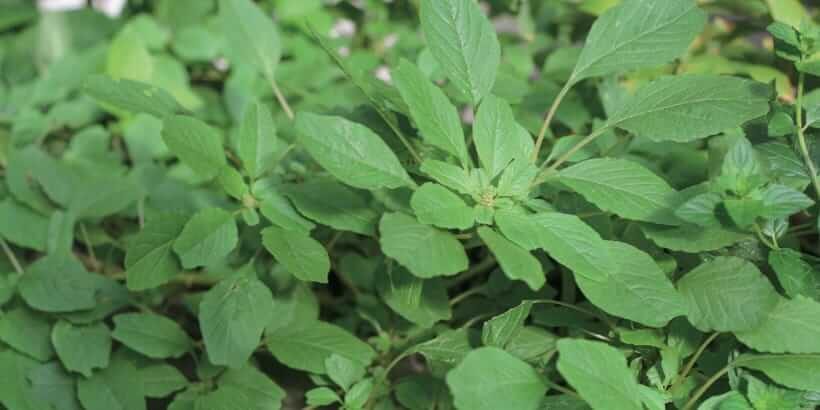
Our love affair with amaranth began long before the pseudo-grain became a trendy staple for gluten-free folk. The luscious leaves of this annual plant are not only packed with a plethora of health benefits – high levels of protein and calcium, aids in digestion and weight loss, and helps improve vision, to name a few. They are also delicious!
Be sure to cook them first to soften the texture and then incorporate them into your favorite summer dish, like this amaranth greens with sumac schwarma spice recipe.
The following excerpt is from Forage, Harvest, Feast by Marie Viljoen. It has been adapted for the web.
Amaranth
Other common names: Pigweed, callaloo, Chinese spinach
Botanical names: Amaranthus hybridus, A. retroflexus, A. palmeri, A. viridis, and other species
Status: Widespread annual weeds, some species are ubiquitous exotics, some are indigenous, some are grown as crops
Where: Gardens, open ground, fields, farmers markets, ethnic markets
Season: Midsummer to late summer
Use: Vegetable, pseudograin
Parts used: Tender stems, leaves, flowers, and seeds
Grow? Yes
Tastes like: Earthy chard
There are more than sixty species of amaranth (forty-seven in the United States), not counting the hybrids, and all are edible.
But amaranths elicit conflicting reactions from humans: love, loathing, and—mostly in the United States—complete indifference. Boxed as pseudocereals, they are revered. Those with pretty leaves (Amaranthus tricolor—a popular crop in China and Southeast Asia) are increasingly grown for food. The genus’s most glamorous members—the statuesque red-tressed supermodels collectively known as red amaranth (A. hybridus)—were domesticated centuries ago. Their seeds were a labor-intensive staple of the Aztec diet. Yet few twenty-first-century shoppers who buy the trendy, gluten-friendly seeds recognize their cousins—the despised plants sprawling in their gardens and yards, or the ignored weeds flourishing along sidewalks in city tree pits. Fewer would consider growing or collecting them for food.
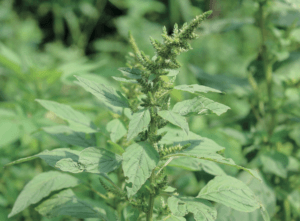 These are the lowly pigweeds. They appear uninvited in gardens and in rows of cultivated crops, where they are met with a deluge of increasingly ineffective and virulent poisons. Pigweeds are often considered toxic to livestock because they absorb so much of the nitrogen from synthetic fertilizer application—converting it to nitrates—that it becomes a reflection of our agricultural malpractices. The plant turns on us, giving as good as it gets. But pigweed is ubiquitous, which means there are plenty of spots away from conventional agriculture sites where you can collect the plants unscathed— delicious and ripe for the picking.
These are the lowly pigweeds. They appear uninvited in gardens and in rows of cultivated crops, where they are met with a deluge of increasingly ineffective and virulent poisons. Pigweeds are often considered toxic to livestock because they absorb so much of the nitrogen from synthetic fertilizer application—converting it to nitrates—that it becomes a reflection of our agricultural malpractices. The plant turns on us, giving as good as it gets. But pigweed is ubiquitous, which means there are plenty of spots away from conventional agriculture sites where you can collect the plants unscathed— delicious and ripe for the picking.
There are cultures that recognize the value of these amaranths. They are important leafy crops in regions as diverse as East Africa, India, and China. In Cape Town, Tipsi Titoti, who is amaXhosa, taught me to make a traditional rural stew based on edible wild greens, known collectively (in the same way as the Greek horta) as morogo. Foraged amaranth (imbuya) is a prized ingredient. Cooked in a little water until tender, with some potato or mealie meal (cornmeal or grits, Stateside), and with nothing more than salt as seasoning, it makes a comforting and nutritious stew. It has fed families when the larder was bare. And if you have to eat a food because you are poor, you can learn to despise it when times are better. I have South African friends who are loath to eat amaranth, because it reminds them of the past.
In Jamaica sonorous callaloo refers both to a stew and to the two edible greens on which it relies: amaranth and taro, which form its soulful and leafy base. When I lived in Harlem, I was able to buy lush greenmarket bunches of amaranth from a Caribbean-born farmer who grows them in upstate New York. A local food store sold them on 125th Street. Ethnic markets and groceries are often the only commercial source for wild greens.
Amaranths are generous summer plants, growing in the hot months when good old spinach and chard and even lamb’s quarters have given up the ghost. Their slightly rough raw texture begs for cooking, and I find them frankly more appealing than cooked spinach. Cooked, both young and mature greens are soft and mild in flavor. Include them in dishes where Swiss chard, spinach, or beetroot leaves feature.
The late-summer flowers and seeds have a different, grainier texture, which is very appealing (as well as nutritious, containing many minerals, as well as protein).
How to Collect and Prepare
Amaranths are one of the few plants that accumulate heavy metals to high levels. Boiling does not affect heavy-metal levels. Avoid collecting amaranths from highway edges or old industrial sites. Also avoid cropland subjected to high doses of synthetic fertilizers.
Pick the tender stems, leaves, flower, and seed heads. At home, refresh wilted amaranth by submerging it in a bowl of cool water. Discard tough stalks, which will not break down in cooking. If you are deeply patient, collect the seeds by shaking mature heads into a paper bag.
Potentially high levels of nitrates, as well as oxalic acid (as in spinach), are reduced by boiling. Boil amaranth greens for a couple of minutes, drain, refresh under cold water, and squeeze dry.
Caution
Do not feed amaranths to babies: Infants under the age of six months have digestive bacteria that convert nitrates to nitrites, which are potentially carcinogenic and can also cause oxygen starvation in the blood. By the time babies are six months old, the acid levels in their digestive systems rise and kill these bacteria. Exercise caution if you are breastfeeding. High and frequent consumption of amaranth can be anti-nutritional in adults, as it might prevent the absorption of some nutrients.
Amaranth Greens with Sumac Schwarma Spice
Serves 4 as a side
These schwarma-inspired greens are such an unexpected hit at home that I make this dish with every green as it comes into season. It is excellent cool, eaten with a dollop of plain yogurt. Bottle the extra spice mixture in an airtight jar. It lasts many months and is divine with slow-roasted lamb or chicken, or stirred into yogurt for dips.
Ingredients
 Wild Schwarma Spice mix
Wild Schwarma Spice mix
1 tablespoon Ground Sumac
2 teaspoons ground cumin
2 teaspoons ground spicebush
1 teaspoon black peppercorns
1/4 teaspoon ground cloves
3 cardamom pods’ seeds
Amaranth Greens
12 ounces (340 g) amaranth leaves, tender stalks, or flower heads
3 tablespoons olive oil
3 cloves garlic, crushed and chopped
2 tablespoons lemon juice
1 tablespoon Wild Schwarma Spice Mix
1/4 teaspoon salt
Topping
1/3 cup (80 ml) yogurt
3 tablespoons water
1/8 teaspoon Ramp Leaf Salt
Procedure
Combine the spices in a small bowl and stir very well. Bring a medium pot of water to a boil and drop in the amaranth for 1 minute. Remove, drain, and refresh in cold water. Squeeze dry. In a large pan over medium heat, warm the oil and add the garlic. Sauté until translucent, then add the amaranth. Add the lemon juice, 1 tablespoon of the spice mix, and the salt, stirring. Cook for 5 minutes.
In a small bowl, thin the yogurt with the water and stir until smooth. Season with the Ramp Leaf Salt. Pour over the amaranth before serving.
Recommended Reads
The Hunt for Wild Huckleberries and Buckwheat Huckleberry Buckle Cake
Recent Articles
These snacks might be too darn cute to take a bite of! Brighten up snack time this winter using fruits and veggies we all know and love.
Read MoreThe scent of fir trees is a holiday staple 🎄 Imagine sipping a festive cocktail infused with the unmistakable taste of fir ✨ This holiday season, elevate your entertaining game by introducing fir to your menu – from classy cocktails to rustic potatoes!
Read MoreLooking for a way to use that leftover Thanksgiving Turkey? Shake things up this holiday season with a game-changing twist. Serve these easy-to-make appetizers with a side of Vietnamese dipping sauce for an extra kick of flavor!
Read More

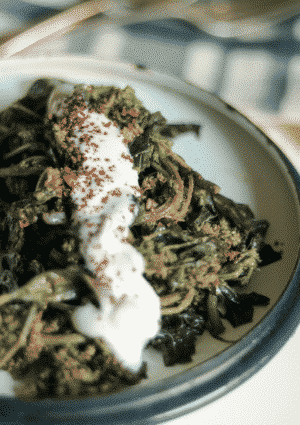 Wild Schwarma Spice mix
Wild Schwarma Spice mix